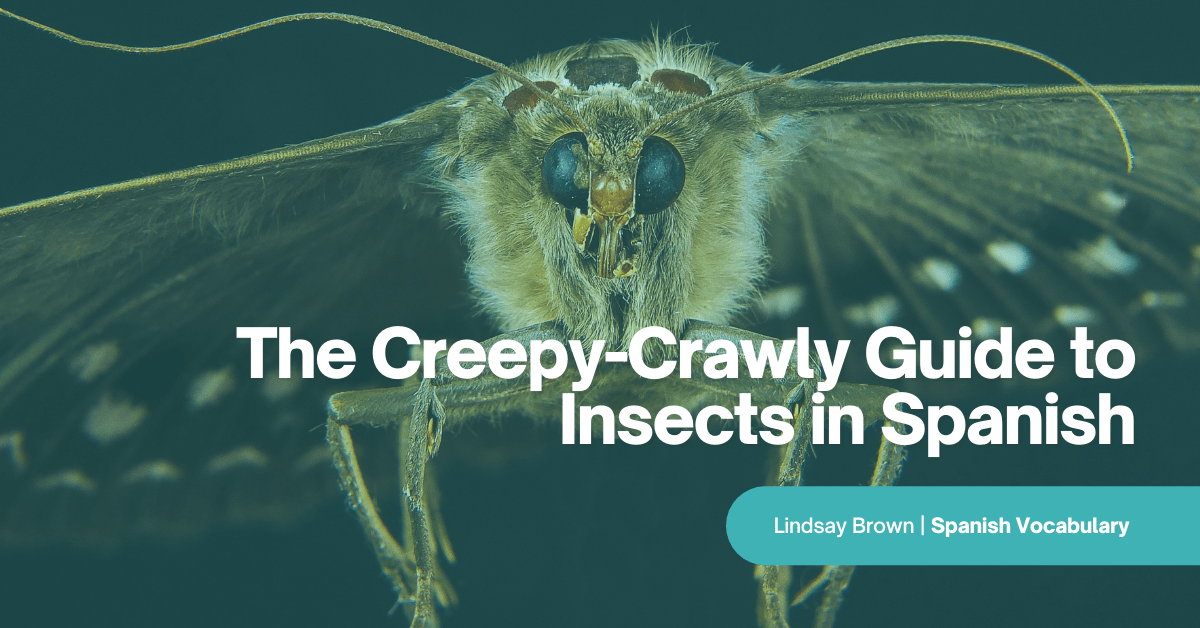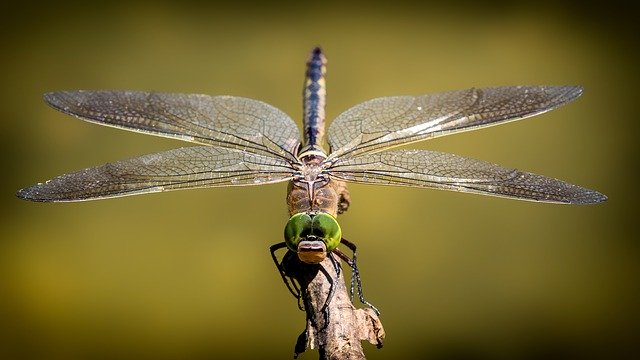
The Creepy-Crawly Guide to Insects in Spanish: Free Printables and More!
Some bite, sting, and stalk their victims, while others zip, zoom, and fly around our heads on a hot day—the fact is, insects are everywhere. There comes a time in every Spanish learner’s life when you must learn about the little creatures who creep about in the night (or day). Let’s learn about insects in Spanish!
The common way to refer to insects in Spanish is to say los insectos, while los bichos is also perfectly acceptable. Then there are synonyms like las alimañas (pests), las plagas (plagues), and las sabandijas (creepy-crawlies) that signal the damage and discomfort these creatures can cause.
For those of you who like to get really specific about bugs, we’re dealing entirely with arthropods in this post, which includes los insectos y los arácnidos (arachnids).
Join 559 million people on the planet who speak Spanish!
Sign up for your free trial Spanish class today. ➡️

Arachnids and Insects in Spanish: What’s the Difference?
To break down the differences between arachnids and insects in the simplest way, we’ll stick to one major distinction:
- Arachnids have 8 legs
- Insects have 6 legs
If you’re into etymology, the vast differences between these two classes in the phylum are long, detailed, and truly fascinating (but completely outside the scope of this article!). To further explore your curiosity, read more about it here.
At some point, you’ve likely mentioned how los mosquitos te molestan or how you saw una abeja en el jardín. Those are basic insects that are essential to know. Now let’s build up your vocabulary skills by adding even more insects in Spanish!

To help promote your studies, we are offering *FREE* arachnid and insect Spanish flashcards!

Simply type in your name and email address below to get them delivered directly in your inbox.
Download FREE Spanish Insect Flashcards
Type in your name and email below! We’ll immediately send this awesome set of Spanish Insects Flashcards to your inbox!
Creepy-Crawly List of Insects in Spanish
Take a deep breath before you jump into our list of insects in Spanish. Soon you might start feeling an uncontrollable urge to itch, but don’t worry—it’s all in your mind. It’s true, las sabandijas (creepy-crawlies) have a visceral effect on our bodies when we begin to think about them!
Intermittent in our list of insects, you’ll see some easy phrases you can start using with your students, kids, or friends who like bugs.
| Spanish | English |
| el abejorro | bumblebee |
| el áfido | aphid |
| el avispón | hornet |
| el bicho de agua | waterbug |
| el chinche | bed bug |
| el ciempiés / el centipedo | centipede |
Example Sentences in Spanish
El abejorro es similar a una abeja, pero este tiene un cuerpo más grueso.
The bumblebee is similar to a bee, but it has a thicker body.
Es difícil eliminar a los chinches porque casi no se ven.
It’s difficult to get rid of bed bugs because you can hardly see them.
A pesar de su nombre, los ciempiés tienen entre treinta y tres cientos cuarenta y cinco patas.
Despite their name, centipedes usually have between 30 and 345 feet.
| Spanish | English |
| el escarabajo | beetle |
| el gorgojo | weevil |
| el grillo | cricket |
| el gusano | worm |
| el gusano de seda | silkworm |
| el mosquito | mosquito |
| el insecto palo | stick bug |
| el parásito | parasite |
Example Sentences in Spanish
El gusano de seda se ha hecho famoso por producir un tejido natural que se usa en la producción de ropa.
The silkworm has become famous for producing a natural fiber that’s used in the production of clothing.
Solo las hembras de los mosquitos se alimentan de la sangre humana.
Only female mosquitoes consume human blood.
El insecto palo tiene forma de una ramita y cuenta con su camuflaje para sobrevivir.
The stick bug looks like a little twig and relies on its camouflage in order to survive.
| Spanish | English |
| el pillojo | lice |
| el saltamontes / el chapulín | grasshopper |
| el tábano / la mosca de burro | horsefly |
| el termite / la hormiga blanca | termite |
| el tisanóptero | thrips |
| la abeja | bee |
| la alimaña | pest / vermin |
| la avispa | wasp |
| la cochinilla | cochineal (rolly polly) |
Example Sentences in Spanish
Parientes de los grillos, los saltamontes emiten un chirrido especial para atraer a su pareja.
Similar to crickets, grasshoppers emit a special chirping sound to attract a mate.
Los termites son una plaga a tener en su casa porque consumen todos tipos de madera.
Termites are a plague to have in your home because they consume all types of wood.
Cuando te pica una abeja, tu piel se pone hinchada.
When a bee stings you, your skin gets swollen.
A los niños les gusta jugar con las cochinillas del jardín.
Kids like to play with the rolly pollies from the garden.
| Spanish | English |
| la cucaracha | cockroach |
| la hormiga | ant |
| la langosta / la cigarra | cicada |
| la libélula | dragonfly |
| la luciérnaga | firefly |
| la mantis religiosa | praying mantis |
| la mariposa | butterfly |
| la mariquita | ladybug |
Example Sentences in Spanish
Nos encanta buscar mariquitas en nuestro jardín.
We love to look for ladybugs in our garden.
La hembra de la mantis religiosa es un caníbal que devora al macho.
The female praying mantis is a cannibal who consumes the male.
En cuanto oscureció, vimos aparecer luciérnagas brillantes.
As soon as it got dark, we saw sparkling fireflies appear.
| Spanish | English |
| la mosca | fly |
| la oruga | caterpillar |
| la polilla | moth |
| la pulga | flea |
| la sabandija | bug, creepy crawly |
| la tijereta | earwig |
Example Sentences in Spanish
Una manera de deshacerse de moscas en la casa es usar una trampa de luz para matarlas.
One way to get rid of flies in your house is to use a light trap to kill them.
Contrario a otras especies de polilla, las polillas de ropa no son atraídas por la luz.
Contrary to other species of moths, clothes moths aren’t attracted to light.
¡Qué bueno que tu perro ya no tiene pulgas!
It’s great that your dog no longer has fleas!
Creepy-Crawly List of Arachnids in Spanish
Arachnids are a classic creepy-crawly. They’ve even inspired horror films like the famous black comedy Arachnophobia. We tend to fear these creatures because a select few of them have deadly bites, like the black widow spider. Others are fast and aggressive like the scorpion.
Our list of arachnids in Spanish is extremely short in comparison to the 100,000 named species in existence. But we’ve got to start somewhere!
| Spanish | English |
| el ácaro | mite |
| el alacrán | scorpion |
| la araña | spider |
| la araña acuatica | water spider |
| la araña de jardín | garden spider |
| la araña lobo | wolf spider |
| la araña patuda | daddy long legs |
| la garrapata | tick |
| el recluto pardo | brown recluse |
| la tarántula | tarantula |
| la viuda negra | black widow |
Example Sentences in Spanish
Algunos ácaros son parásitos que pueden infectar a un humano.
Some mites are parasites that can infect a human.
A las arañas patudas les gusta hacer sus telarañas en las esquinas del cuarto de baño.
Daddy-long-leg spiders like to make their webs in the corners of bathrooms.
Después de recorrer el bosque con tu perro, hay que inspectarlo por garrapatas.
After trekking across the woods with your dog, you must inspect him for ticks.
¿Cual es tu insecto favorito, y por qué?
What’s your favorite insect, and why? Let me know in the comments!
Talk About Insects in Spanish
Haven’t had your fill of insects studies in Spanish? Sign up for a free trial class with one of our certified, Spanish-speaking teachers from Guatemala and start talking about insects in Spanish today!
Looking for free Spanish homeschooling resources? Check out these posts!
- 10 Homeschooling Styles You Need to Explore in 2023
- Local Learning Networks: Finding Homeschool Co-ops Near You
- Home Sweet Classroom: Creating Engaging Spanish Lessons at Home
- 10 Websites Offering Short Stories in Spanish for Beginners
- Can Homeschoolers Participate in Sports?
- 10 Tips for When Homeschool Isn’t Working
- Is There Homeschooling in Latin America?
- 10 Productive Back-to-School Activities for Your Spanish Class
- Top-Rated Accredited Online Spanish Classes for Kids - February 22, 2023
- 6 Compelling Reasons Why Your School Should Outsource Spanish Class - February 3, 2023
- 20 Free Spanish Books, Novels, and Stories in PDF and Printables - January 25, 2023






